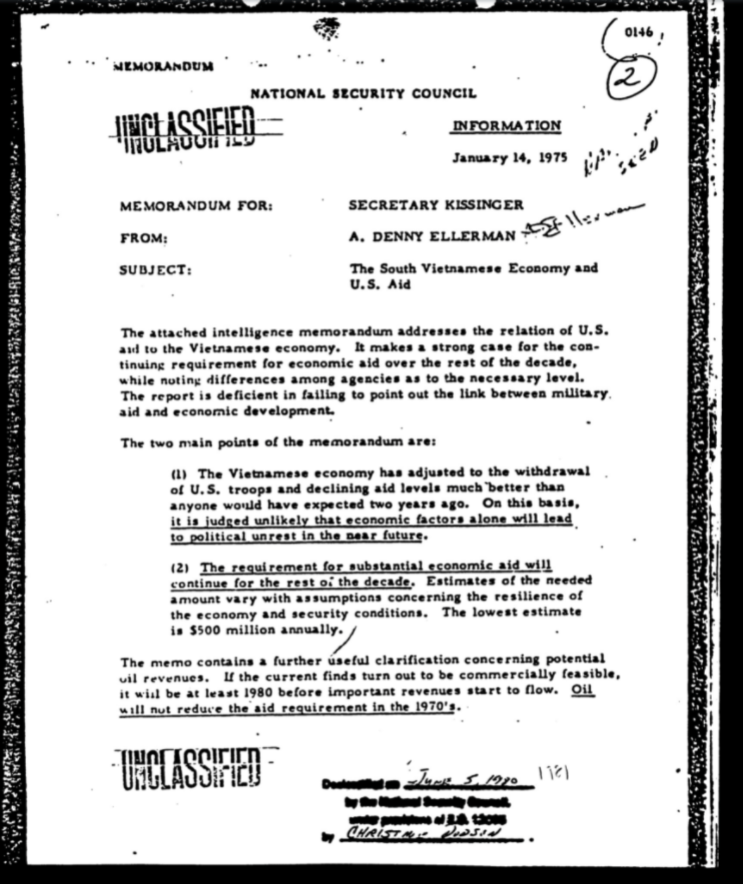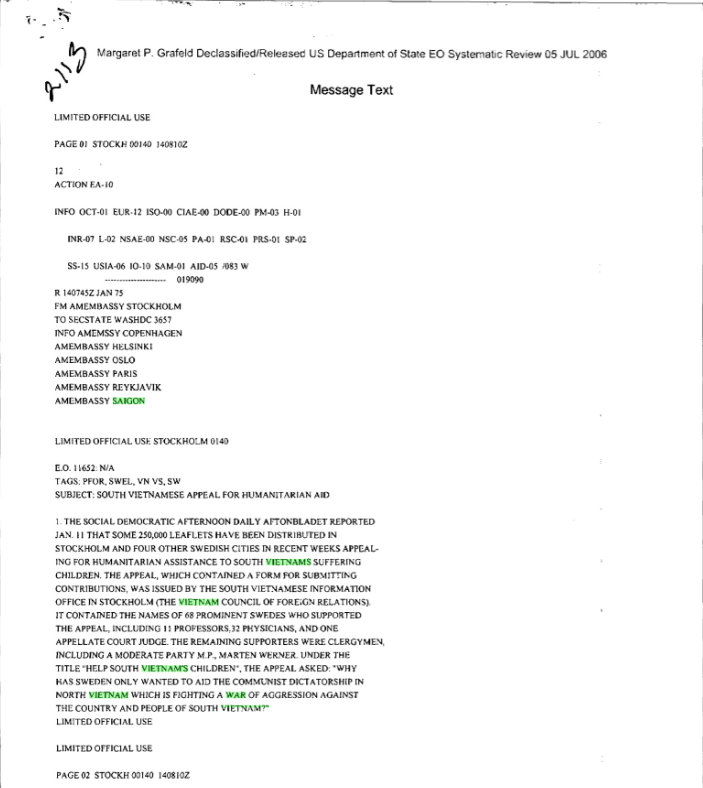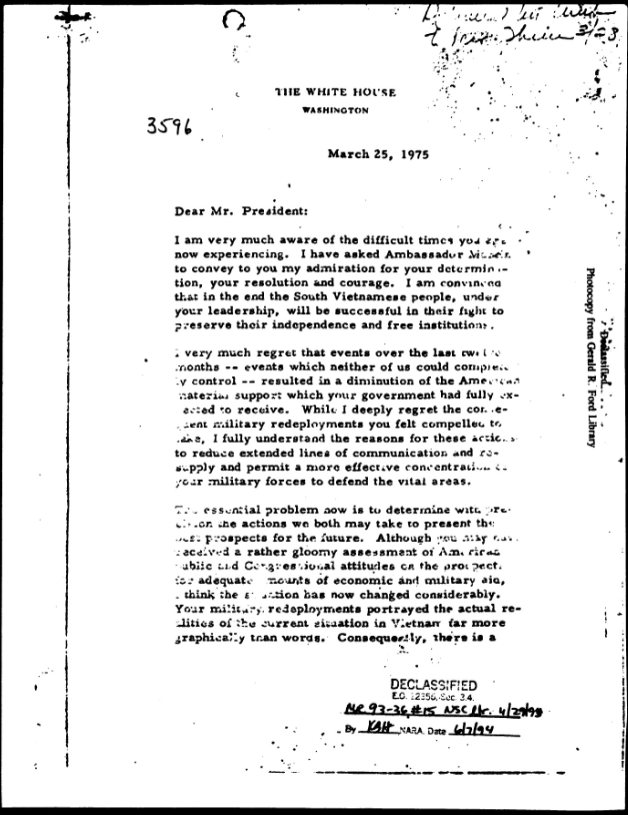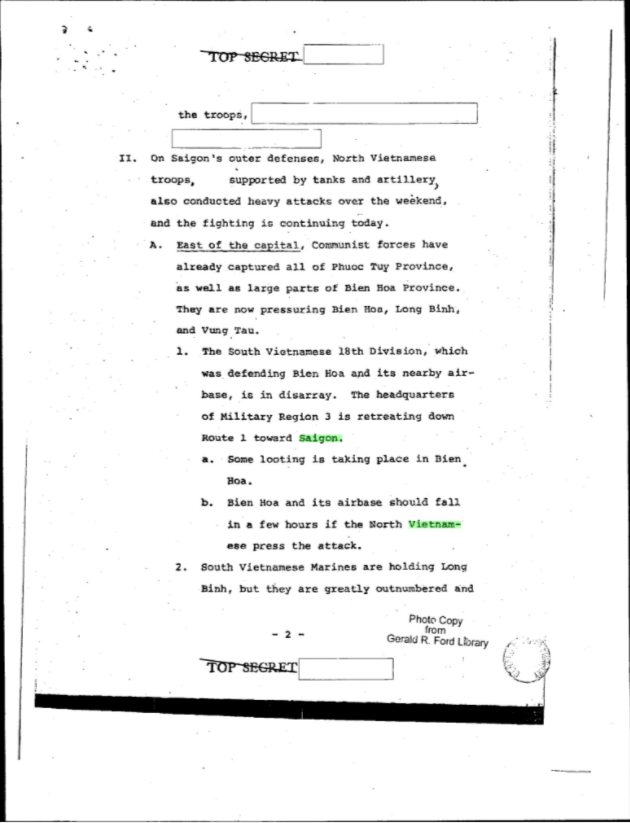

Let's Talk!
If you have questions about using Gale LibGuides or A-to-Z list import files, please feel free to reach out to Gale's Academic Outreach & Engagement team. We are happy to help you customize, copy, share and upload materials to your Institution's site.
This guide focuses on documents that were dated just before the Fall of Saigon to see what these documents can tell us about this short time period, using documents between January 1, 1975 and May 31, 1975 from Gale’s US Declassified Documents Online archive. This search produced interesting results and the most fascinating of them are examined below in chronological order. 
The first document is a 32-page memorandum to Secretary of State Henry Kissinger about the South Vietnamese economy and US aid. According to this document, the South Vietnamese economy had fared relatively well compared to expectations and adjusted well to the withdrawal of US troops and declining aid levels. Although, the memo does indicate that the need for substantial economic aid will continue to be necessary for the next decade, and that the encouraging economic trends depended on the continuation of the military stalemate between North and South Vietnam.
On the same day, Kissinger also received a message from US Ambassador Robert Strausz-Hupe informing him of the distribution of around 250,000 leaflets in Stockholm and four other Swedish cities appealing for humanitarian aid for children suffering in South Vietnam. The appeal for aid was issued by the South Vietnamese Information Office in Stockholm and also included the following text: “Why has Sweden only wanted to aid the communist dictatorship in North Vietnam which is fighting a war of aggression against the country and people of South Vietnam?” The message also details the Swedish response to the campaign and the hostile tone of the newspaper Aftonbladet in its reporting on these leaflets and makes the point that an effort has been made to keep the appeal as humanitarian as possible – focusing on the suffering of South Vietnamese children instead of Northern aggression seems a good way to do so. It is fascinating to see how important foreign relations and the global perception of the conflict were to the US government at the time.
issued by the South Vietnamese Information Office in Stockholm and also included the following text: “Why has Sweden only wanted to aid the communist dictatorship in North Vietnam which is fighting a war of aggression against the country and people of South Vietnam?” The message also details the Swedish response to the campaign and the hostile tone of the newspaper Aftonbladet in its reporting on these leaflets and makes the point that an effort has been made to keep the appeal as humanitarian as possible – focusing on the suffering of South Vietnamese children instead of Northern aggression seems a good way to do so. It is fascinating to see how important foreign relations and the global perception of the conflict were to the US government at the time.
The focus on the foreign press continues as on January 29, 1975 Kissinger receives a message with information on Chinese media reaction to the current North Vietnamese offensive in South Vietnam’s Phuoc Long province. The PRC media had thus far refrained from commenting on the communist offensive but in the first comment on Vietnam that year the NCNA (Chinese news agency) condemned the South Vietnam regime for repeated violations of the Paris Peace Accords and frames the communist offensive as a counterattack in self-defence. The piece only predicts that Saigon will continue to suffer defeats if they continue to break the Paris agreement. This lukewarm response is seen as a possible further indication of strain in the Hanoi-Peking relationship.
On March 18, 1975 Deputy Chief of Mission Wolfgang Lehmann provides Kissinger with details of South Vietnamese press coverage of the North Vietnamese offensive in South Vietnam. A US Congressional delegation visit dominated coverage through March 10, but some newspapers like Dan Chu and Tien Tuyen devoted front page coverage to reports of simultaneous North Vietnamese attacks in Kontum and Quang Ngai provinces on March 2, 1975. By March 15, news of the North Vietnamese offensive dominated the front pages of all Saigon dailies and two newspapers published eyewitness reports of people’s courts and executions taking place in newly captured areas taken by the communists.
On March 25, 1975 President Gerald Ford wrote a letter to Nguyen Van Thieu, President of the Republic of Vietnam. In this letter President Ford  congratulates Thieu on his determination, resolution and courage and relays his conviction that in the end the South Vietnamese people will be successful in their fight to retain their freedom and independence. President Ford assures Thieu that the American commitment to South Vietnam is as strong as ever and that his government’s firm intention is to ensure the Republic of Vietnam’s economic viability and capability to defend itself.
congratulates Thieu on his determination, resolution and courage and relays his conviction that in the end the South Vietnamese people will be successful in their fight to retain their freedom and independence. President Ford assures Thieu that the American commitment to South Vietnam is as strong as ever and that his government’s firm intention is to ensure the Republic of Vietnam’s economic viability and capability to defend itself.
Another significant document available from this time period (January 1, 1975 – May 31, 1975) is a Central Intelligence briefing in preparation for a  Washington Special Actions Group meeting on the situation in Vietnam. According to the briefing, the fighting had now reached Saigon itself. North Vietnamese troops, with tank and artillery support, conducted heavy attacks over that weekend, and east of the capital communist forces had captured the province of Phuoc Tuy and large parts of Bien Hoa province. In the west the North Vietnamese were attacking Tan An, the capital of Long An Province. The Briefing details South Vietnamese troop movements and goes on to report that General Duong Van Minh assumed the presidency and had called for a cease-fire.
Washington Special Actions Group meeting on the situation in Vietnam. According to the briefing, the fighting had now reached Saigon itself. North Vietnamese troops, with tank and artillery support, conducted heavy attacks over that weekend, and east of the capital communist forces had captured the province of Phuoc Tuy and large parts of Bien Hoa province. In the west the North Vietnamese were attacking Tan An, the capital of Long An Province. The Briefing details South Vietnamese troop movements and goes on to report that General Duong Van Minh assumed the presidency and had called for a cease-fire.
As these glimpses into the past demonstrate, primary sources are invaluable if we want to research historical periods, institutions or regimes. Primary sources give us a window into the past and let us examine what information the individuals involved were basing their actions on – what meetings were being held, who was attending these meetings and what was on the agenda. For example, if you wanted to research which international newspapers the US government at the time considered important or influential, a good place to start would be to see which international newspapers were considered important enough to feature in US State Department memorandums that year. Gale’s US Declassified Documents Online archive is a rich resource for everyone who wants to get their hands on declassified documents in order to take their research to the next level.
The content of this LibGuide was adapted from the original author’s blog post which can be found here. Some of the author’s original words have been edited to accommodate general research inquiry related to the topic.
Gale is committed to helping students discover research insights to advance learning and research. Gale Ambassadors are students who work within their own university to increase awareness of the Gale primary source collections available to their fellow students. Our Ambassadors study a variety of different disciplines, and all are open to receiving thoughts or questions from other students at their university about Gale Primary Sources.